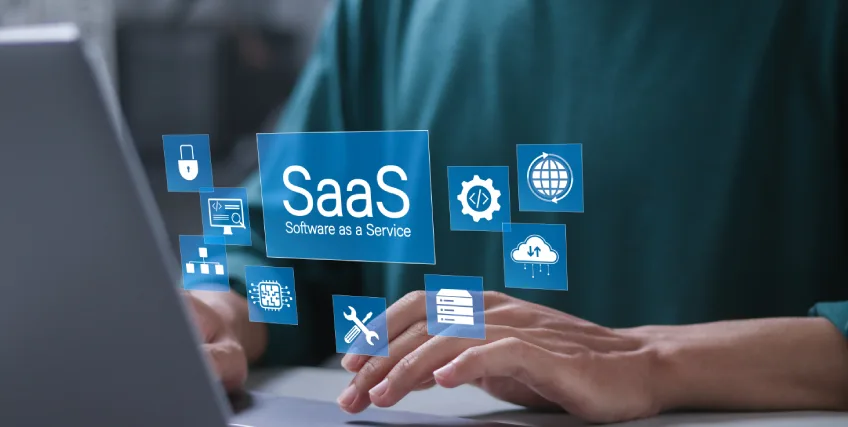Using a SaaS Line of Credit to Manage SaaS Cash Flow Gaps
Jul 3, 2025 | Last Updated on: Jul 7, 2025

As billionaire entrepreneur Sir Richard Branson once said, “Never take your eyes off the cash flow because it’s the lifeblood of business.” That’s especially true for Software as a Service (SaaS) companies.
A key challenge of the SaaS business model is that many companies operate on a flat monthly or yearly subscription, and recurring revenue often comes in slowly over time, particularly for early-stage SaaS businesses.
Meanwhile, costs like salaries, marketing, software tools, and customer support need to be paid right away. This time gap can create cash flow problems. Even if your company is signing new customers and growing quickly, you might still struggle to pay your bills, invest in new features, or hire more team members when needed.
A SaaS line of credit can be a smart tool to help you handle these cash flow gaps and support uneven revenue streams, especially during your company’s growth stage. It can give your business access to cash when it needs it the most without taking on long-term debt.
We’ll explain how a line of credit loan works and how your SaaS company can use it to help you maintain control of your business’s finances.
Understanding Cash Flow Gaps in SaaS
An important component of any thriving business is its scalability. However, in a SaaS business, any growth in your business experiences can contribute to cash flow gaps.
Every new customer you acquire costs money, so it makes sense to want to retain them. Strong customer retention improves recurring revenue predictability but requires upfront costs to onboard and support them throughout the customer journey.
Meanwhile, you still have other operational expenses to consider, including:
- Hosting and cloud services
- Software and product development costs
- Marketing and sales expenses
- Salaries and benefits for employees
- Hardware and IT equipment
- Professional services, such as legal and accounting consultants
- Office space and utilities
If initial expenses outweigh monthly income, it can cause a significant cash flow gap. Sometimes scaling fast makes the problem even worse, especially if your cost of acquisition is high. The financial strain for high-growth SaaS businesses can be tremendous without sufficient planning or financing solutions to fill the gap.
By understanding where and when these gaps happen, you can plan better and make smarter decisions. A SaaS line of credit can help cover these short-term gaps so you can keep your business running smoothly and growing the way you want it to.
What is a Line of Credit?
A line of credit is a flexible form of financing that can give your SaaS company access to capital as needed. Instead of a traditional business loan, which provides a lump loan sum all at once, the line of credit works more like a credit card. You’re approved with a maximum credit line, and you control the amount of capital you borrow. Interest is paid only on what you’ve borrowed or spent.
A SaaS line of credit can help provide the working capital you need to pay for almost any part of your business’s operations, ranging from employee compensation to marketing campaigns, and more.
Benefits of Using a SaaS Line of Credit
There are many advantages to having access to a SaaS line of credit.
1. Faster Access to Capital
A SaaS line of credit is a type of fast funding you can use if a business opportunity comes up or you need to pay for emergency business expenses. For example, if essential equipment breaks down or a technology used in your SaaS business needs to be repaired, a line of credit can help you meet those needs to minimize downtime of your operations.
2. Greater Flexibility and Control of Your Finances
With a SaaS line of credit, you only borrow as needed from the credit line. This gives you greater flexibility to respond more quickly to changing needs. With interest charged only on the amount of credit used, your SaaS company can manage its finances more efficiently.
3. Enhanced Confidence and Decision-Making
Knowing that you have a reliable source of capital to use when it’s urgently needed can help your SaaS company take calculated risks more confidently, plan with greater certainty, and focus on long-term strategies without worrying about short-term cash shortfalls.
For example, a line of credit can allow you to hire key talent, add new features to your software, or launch a marketing campaign at the right time.
4. Stability in Your SaaS Company’s Cash Flow
The downside of a SaaS business is inconsistent cash flow, particularly when it’s newer. A SaaS business line of credit can help ensure your business runs more smoothly, despite cash flow challenges. It can help cover bills and expenses during seasonal downturns or low-revenue periods.
5. Capital to Grow Your Saas Business
A SaaS line of credit can provide the growth capital your business needs to scale efficiently and act more strategically without having to wait on delayed revenue. For example, you may want to add AI chatbots or hire more talent to focus more on product development.
6. Retain Ownership Without Equity in Your Business Being Dilutive
A Saas line of credit is a type of non-dilutive funding. This means it doesn’t require you to give up any ownership of the business or its assets. This allows you to retain more control of your business.
7. Build Business Credit History
Like a business credit card, a SaaS line of credit can help boost your business credit score and rating, particularly when you use the credit line responsibly and repay it on time if the lender reports to credit bureaus. Building good credit can help you get small business loans with more favorable terms that include higher loan amounts and lower interest rates.
Tips for Using a Line of Credit Effectively
A SaaS line of credit can be a valuable financial resource for your business. However, it must be used wisely to maintain the financial integrity of your SaaS business. Without solid planning and guidelines for its use, it can lead to unnecessary financial strain and debt.
Here’s how to make the most out of your credit line.
Use your SaaS line of credit only for short-term needs or one-time expenses.
Avoid using your line of credit for recurring costs or long-term expenses. Use it for activities that align with driving profitability for your business, such as a referral program to reduce customer acquisition costs or upselling strategies. You should also reserve your line of credit for times when your expenses are outpacing incoming revenue.
Monitor your credit line use and interest costs.
Monitor how often you use your SaaS credit line, how much you borrow, and what you use it for. Avoid overborrowing and pay on the credit line on time.
Take note of how much interest you’re charged and what type of fees the lender is assessing. Watch for late payment charges and other fees that can lower your profit margins.
Also, track key financial metrics such as churn rate, customer acquisition cost (CAC), and lifetime value (LTV) to ensure that your line of credit supports long-term growth rather than short-term overspending.
Understand the terms of your line of credit.
It’s essential to do your due diligence and understand that the repayment terms for a SaaS line of credit vary by lender. Some allow only six months to repay the credit line, while others offer up to 18 months. Many lines of credit have variable interest rates, while some have fixed interest rates.
You’ll also want to note how much the monthly payments are and budget for them to avoid missed payments and penalties and to maintain a healthy cash flow while using the credit line. Read the agreement before signing and committing to anything.
Forge a good relationship with your lender.
Find a lender that prioritizes the customer relationship. Chances are, you’ll need several small business loans during the course of your SaaS operations. It pays to have a lender who will also serve as an advisor to help you make wiser financial choices.
Maintaining communications with your lender is also important if there’s a problem while using your line of credit. For example, if your financial situation changes or you need to increase your credit limit, keep that line of communication open so your lender can help.
Conclusion
Cash flow gaps are a common concern in business, especially for SaaS companies with fluctuating revenues. With subscriptions accounting for most of your business’s revenue and expenses needing to be paid upfront, a SaaS line of credit can be a lifeline for your company.
A line of credit is a flexible financing solution that can help bridge short-term cash gaps in your SaaS business.
When used responsibly, your SaaS line of credit can offer you more stability during unstable financial periods, help you make smarter financial decisions, and empower you to better grow your business.
Fast access to SaaS capital during key times can mean the difference between your SaaS business surviving and thriving, or struggling. With thoughtful planning, careful monitoring, and responsible repayment, a SaaS line of credit can help you move your business forward and turn short-term flexibility into long-term success.
FAQs About a SaaS Line of Credit
1. What other business financing options are there besides a line on credit?
Other types of financing to consider are equity financing, venture capital, a line equity loan, term loans, traditional bank loans, SBA loans, and revenue-based financing. Revenue-based financing is based on monthly recurring revenue (MRR) or annual recurring revenue (ARR). In both, repayments are based on a percentage of estimated future receivables.
2. What is a SaaS line of credit, and how does it differ from other SaaS funding options?
A SaaS line of credit is a flexible form of Saas financing that allows you to borrow funds when you need them instead of receiving a lump sum like a traditional loan. Unlike equity funding, it doesn’t require giving up ownership, making it ideal for managing short-term needs while maintaining control of your business.
3. Can a line of credit help Saas startups that use bootstrapping to get their business off the ground?
A SaaS line of credit is a great strategy when you’ve started your business with your personal funds and you're trying to avoid significant debt financing and small business loans.
4. How can a line of credit help manage accounts receivable delays?
When accounts receivable are delayed, a line of credit can provide immediate liquidity. This ensures your SaaS business can pay its vendors and employees on time without waiting for customer payments.
5. Where can I get a SaaS line of credit?
Banks, credit unions, and alternative lenders all offer different lines of credit. Banks sometimes require collateral and a personal guarantee. Alternative lenders offer faster access to funding and SaaS-specific options like MRR and ARR-based solutions. They’re ideal for flexible SaaS financing needs.




